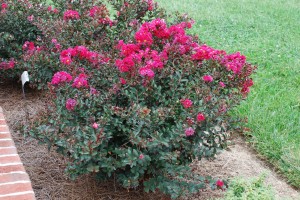Over the past quarter century crape myrtles (Lagerstroemia spp.) have become the quintessential flowering shrubs of summer along with hydrangeas (Hydrangea spp.), altheas (Hibiscus syriacus), and chaste tree (Vitex agnus-castus).
Crape myrtles are grouped into four distinct size categories: trees, large shrubs, medium shrubs and dwarf sizes. A spate of new dwarf cultivars have raised the bar. All dwarf cultivars listed below are rated for zone 7 or higher, but have performed well in zone 6-b (where I garden).
Treat dwarf crapemyrtles like perennials. Pruning and fertilizing bring them back to life. Wait until mid-April to revive them. Remove the old seed heads and assess the extent of winter dieback. It involves mostly small pruning cuts. From this point, dwarf crape myrtles remain mostly trouble-free the rest of the year.
Cherry Dazzle™ produces cherry red blooms from summer into fall. Shrubs grow 3-5 feet in height.
‘Centennial’ – sister seedling to ‘Victor’; 5 to 6 feet in height, but easily maintained at 3 to 5 feet height and spread/ bright lavender flowers/ leaf mildew resistance/ orange fall color/ reddish-brown mature bark.
‘Pink Ruffles’ – ruffled, pink blossoms/ orange – red fall leaf color/ grayish brown bark.
‘Pokomoke’ – 3 to 4 feet height and width /dense glossy green foliage/deep rose pink flowers.
Tightwad Red ® (L. indica ‘Whit V’) – dark red sterile flowers (no seed pods) / purplish-green foliage that’s highly leaf mildew resistant.
‘Victor’ – 5 to 6 feet height and 3 to 4 feet wide/ red flowers/green summer foliage/ red fall color.
Crape myrtles grow best in full sun and in moist fertile soil. They tolerate hot dry sites once shrubs become established after their first year. They grow well in limited planting spaces such as urban parking lots and in small pavement cutouts if limited irrigation is supplied. They tolerate clay and alkaline soils.
Add dwarf crape myrtles when planning a new garden bed.


 Posted in
Posted in 
